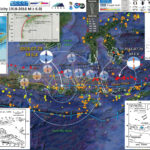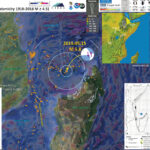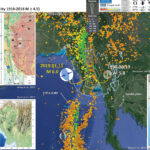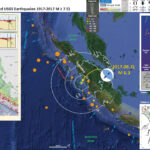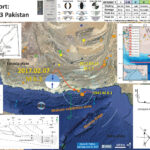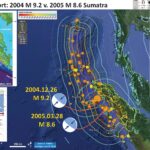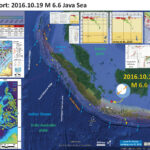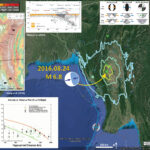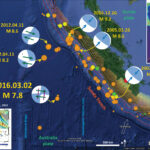Earlier today there was a shallow M 6.4 earthquake with an epicenter on the island of Lombok, Indonesia. With a hypocentral depth of about 7.5 km, this size of an earthquake can be quite damaging. The USGS PAGER estimate of…
Earthquake Report: Madagascar!
Today there was an earthquake in a region that we don’t hear about that often. Madagascar is off the coast of southeastern Africa and the oceanic basin to the west is likely formed as part of the East Africa Rift…
Earthquake Report: Burma!
There was an earthquake in Burma today! The epicenter plotted very close to the Sagaing fault (SF), a major dextral (right-lateral) strike-slip fault system, part of the plate boundary between the India and Eurasia plates. This fault system accommodates much…
Earthquake Report: Mentawai, Sumatra
We just had an earthquake in the Mentawai region of the Sunda subduction zone offshore of Sumatra. Here is the USGS website for this M 6.3 earthquake. Based upon the hypocentral depth and the current estimate of the location of…
Earthquake Report: Bengkulu (Sumatra)!
Last night (my time) while I was tending to other business, there was an earthquake along the Sunda Megathrust. Here is the USGS website for this M 6.4 earthquake. This M 6.4 earthquake happened down-dip (“deeper than”) along the megathrust…
Earthquake Report: Makran subduction zone (Pakistan)!
There was a good sized earthquake along the Makran subduction zone. This subduction zone is a convergent plate boundary where the Arabia plate subducts (goes beneath) northwards under the Eurasia plate. There has been one aftershock reported by the USGS.…
Earthquake Anniversary: Sumatra-Andaman 2004 M 9.2 & 2005 M 8.6
On 26 December 2004 there was an earthquake with a magnitude of M 9.2 along the Sumatra-Andaman subduction zone (SASZ). This earthquake is the third largest earthquake ever recorded by modern seismometers and ruptured nearly 2,000 km of the megathrust…
Earthquake Report: Java Sea!
Last night as I was finishing work for the day, I noticed an earthquake in the Java Sea, just north of western Java. Here is the USGS website for this M 6.6 earthquake. This earthquake is extensional and plots very…
Earthquake Report: Burma!
Well, there was an earthquake about 6 hours ago in Burma. This M 6.8 earthquake was rather deep, which is good for the residents of that area (the ground motions diminish with distance from the earthquake hypocenter). Here is the…
Earthquake Report: Sumatra!
We just had a M = 7.8 earthquake southwest of the Island of Sumatra, a volcanic arc formed from the subduction of the India-Australia plate beneath the Sunda plate (part of Eurasia). Here is the USGS website for this earthquake.…

